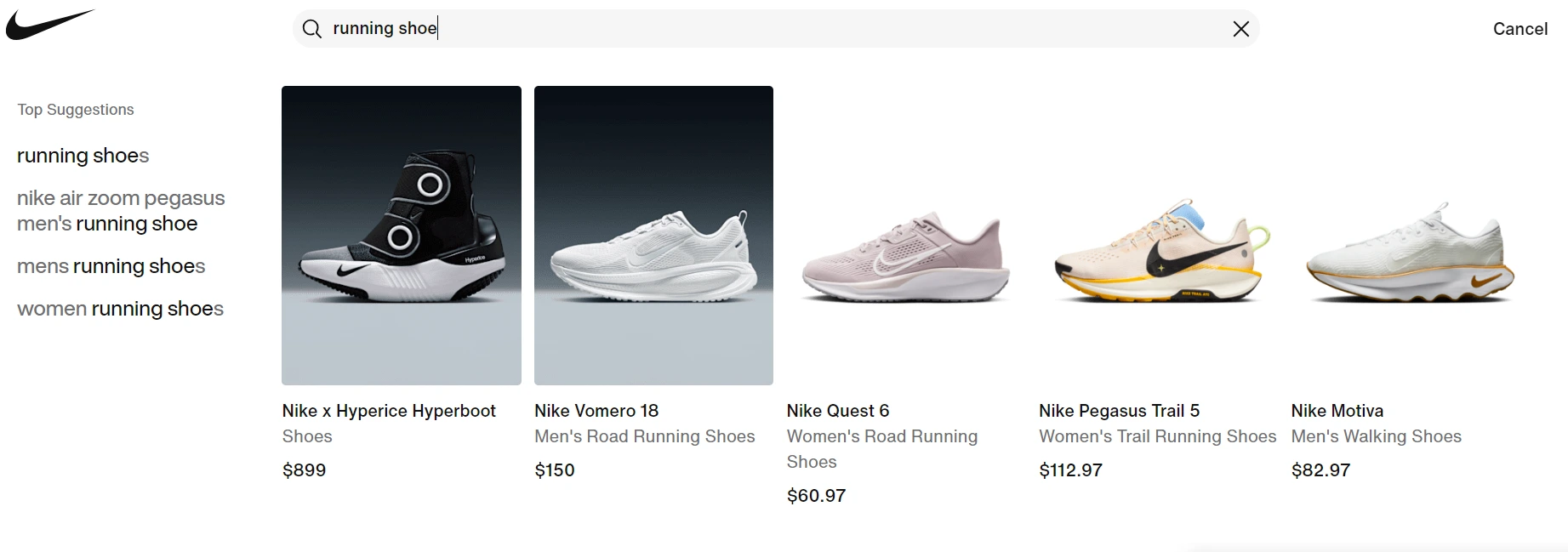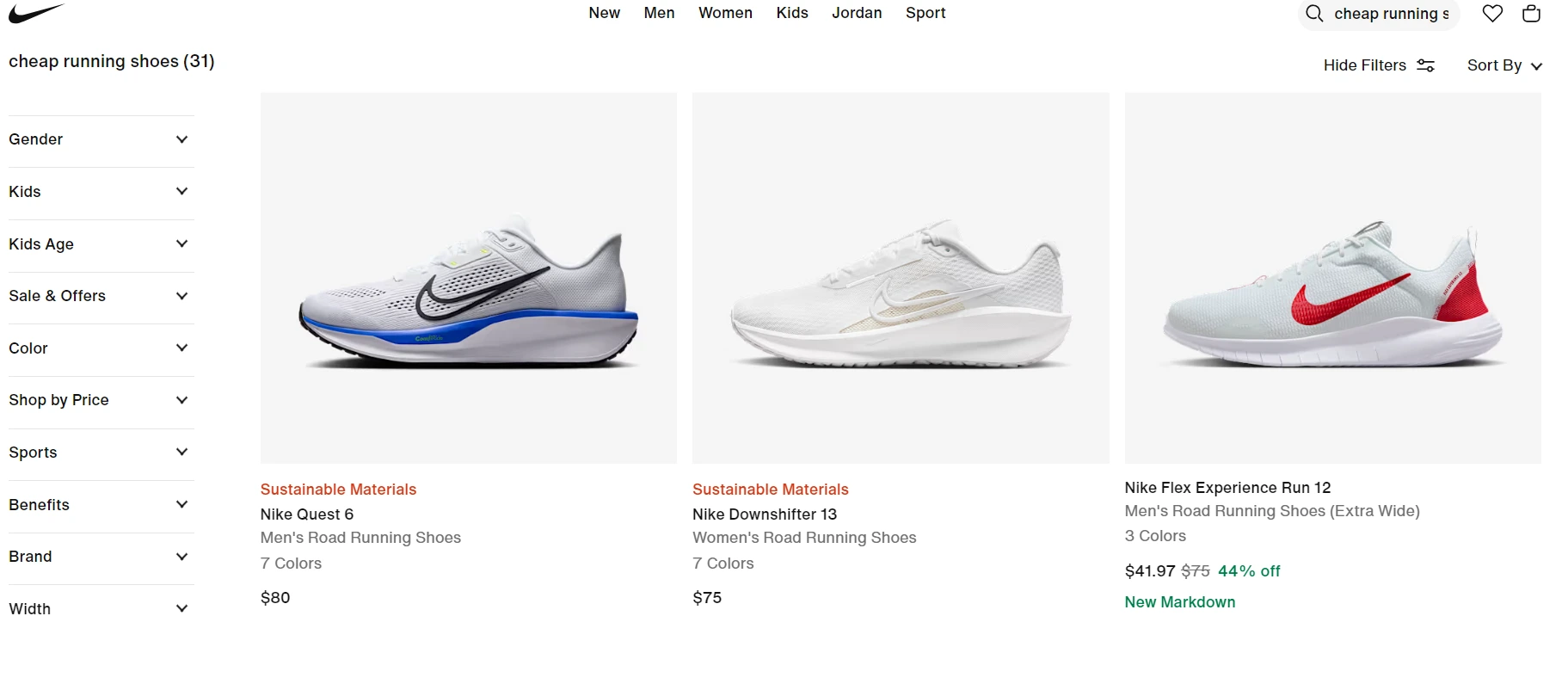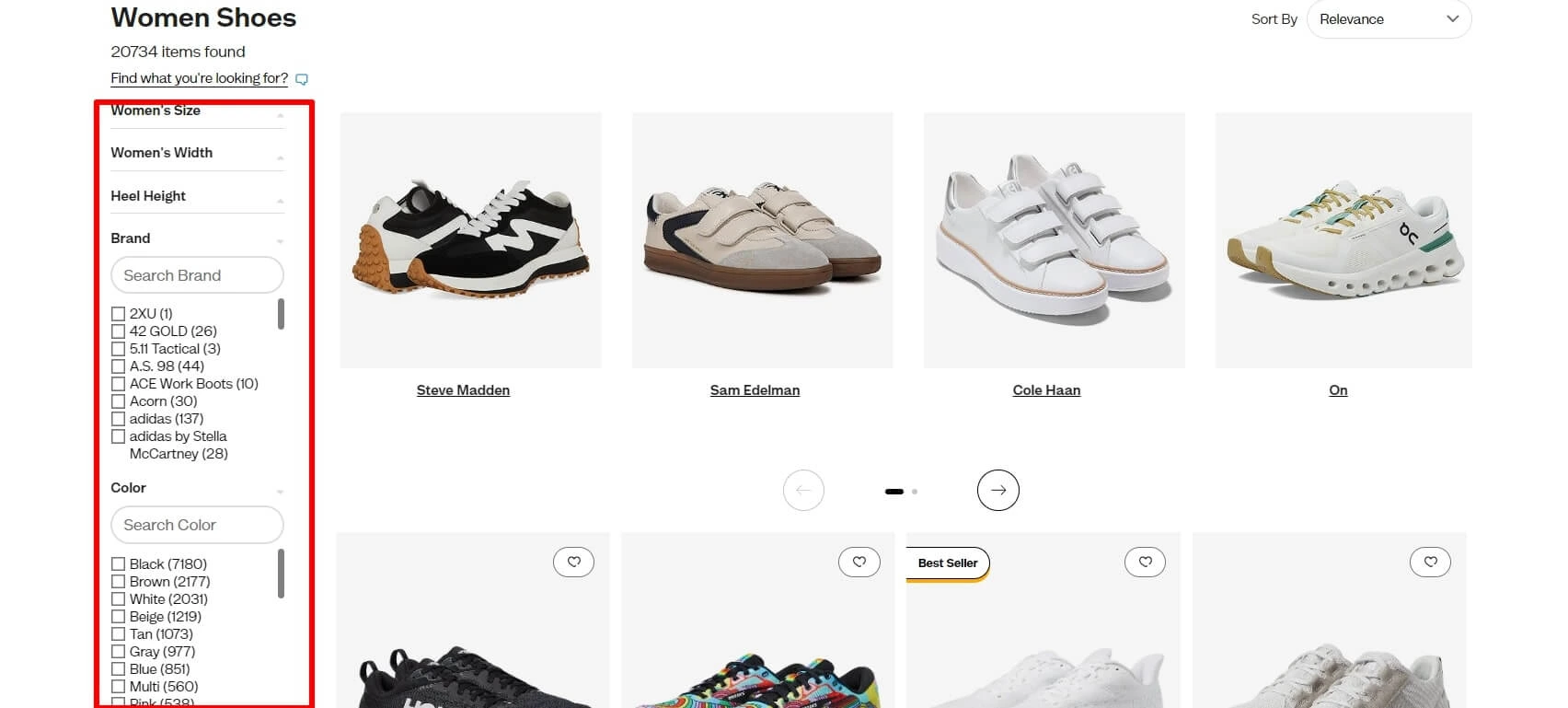Table Of Contents:
A shopper lands on your site, types in “black waterproof hiking boots under $100”, and hits enter—only to be shown umbrellas, sneakers, and a “no results found” message. Within seconds, they bounce. Now multiply that moment by thousands of site visitors every month. That’s a mountain of lost revenue.
Nearly half (43%) of retail shoppers go to the website’s search bar when they arrive.
Visitors who use site search convert up to 5–6x higher than those who don’t, but only if the search functionality e-commerce delivers.
Without it, even the most loyal customers can lose patience, abandon their carts, and head straight to competitors.
In today’s hyper-competitive market, having the best site search for e-commerce isn’t optional—it’s essential. Effective e-commerce search optimization can dramatically improve online store search performance, reduce friction in the customer journey e-commerce search, and help users find exactly what they’re looking for—whether on desktop or mobile e-commerce search.
This blog will break down why site search is a primary conversion driver, what makes it effective, and how to implement five proven strategies to optimize your e-commerce site search for better performance. Whether you’re fine-tuning mobile ecommerce search or looking to enhance search analytics, e-commerce, and relevance ranking e-commerce, this guide will help you build the best site search for ecommerce that actually converts.
The Undeniable Link: Site Search and Ecommerce Conversions
There’s no sugarcoating it—site search can make or break your ecommerce conversions. Research shows that site search users convert at 1.8 to 2.5 times the rate of regular visitors. Why? Because they’re not just browsing—they’re buying. These are high-intent users who already have a product in mind. They’re in action mode, not window-shopping.
A well-structured e-commerce search optimization strategy ensures that your search engine delivers fast, accurate, and relevant results.
Features like:
- Autocomplete e-commerce search
- Search filters e-commerce
- Faceted search e-commerce
- Semantic search e-commerce
…all play a role in creating a streamlined shopping experience.
But when the experience is clunky, that’s where conversions fall apart. A poor search journey—filled with irrelevant results, bad relevance ranking for e-commerce, or a dead-end no results page—frustrates users. They bounce. They abandon carts. Your store loses revenue.
Effective semantic search for e-commerce doesn’t just return keywords—it understands intent. Layer in search analytics for e-commerce, and you gain powerful insights to optimize continuously. Users expect precision even on mobile, where mobile e-commerce search behavior is often more urgent. Fast and accurate product finding online is no longer a luxury—it’s expected.
When done right, the best site search for e-commerce acts like a personal assistant, guiding users quickly and accurately to what they want.
The result?
- Higher conversion rates
- Increased repeat purchases
- Stronger customer loyalty
Supercharge Your Site Search & Product Discovery
Discover how our AI can transform your product discovery and boost conversions.
Strategy 1: Implement Intelligent Autocomplete and Suggestions
Autocomplete isn’t just about completing a sentence—it’s about completing the thought. In modern e-commerce search optimization, autocomplete functions as a digital mind-reader, helping users find products faster, with less friction.
What It Is:
Intelligent autocomplete leverages:
- Predictive text and behavior analysis
- Real-time data
- To suggest relevant queries, product names, brands, and categories the moment a user begins typing.
It’s more than just a convenience—it’s a cornerstone of autocomplete ecommerce search that shapes how efficiently shoppers navigate.
Why It Matters:
- Saves time and effort by showing results instantly
- Reduces typos and failed searches, minimizing frustration
- Uncovers product possibilities a user may not have considered—great for discovery
- Highlights popular and trending items, which can drive higher average order values
- Boosts the customer journey e-commerce search by making navigation smoother
Best Practices for Implementation
- Predictive Typing: Use AI-powered engines to anticipate intent
- Visual Suggestions: Add thumbnails, prices, and quick links within suggestions
- Category + Brand Surfacing: Don’t just suggest products—offer up categories and collections
- Typo Tolerance: Gracefully handle misspellings and partial inputs
- Personalization: Tailor suggestions based on user behavior, previous searches, and geolocation
Example
Nike exemplifies effective autocomplete ecommerce search. When users begin typing in the search bar, Nike’s site provides:
- Brand suggestions like Nike or Jordan
- Product thumbnails with prices
- Category matches such as “running shoes” or “basketball gear”
This implementation enhances the search functionality of the e-commerce experience, making it one of the best in the industry.

Strategy 2: Leverage Advanced Filtering and Faceted Search
Scrolling through 1,000 results for a “black dress” can overwhelm users. That’s where faceted search ecommerce shines—it helps people narrow down choices with precision.
What It Is
Faceted search allows users to refine search results through filters such as:
- Brand
- Price
- Color
- Size
- Ratings
- Material
It’s essential for simplifying product finding online across extensive catalogs.
Why It Works
- Narrows down extensive inventories quickly
- Reduces decision fatigue, making shopping less stressful
- Speeds up product discovery, especially on mobile devices
- Improves search functionality, ecommerce, and overall conversion rates
Best Practices
- Relevant Filters: Customize filters per category. A shirt page doesn’t need “battery life.”
- Multi-Select Capability: Let users apply more than one filter (e.g., red + medium + cotton)
- Live Count Display: Show how many results match each filter option
- Mobile Optimization: Ensure filters are tappable, collapsible, and visible in mobile ecommerce search
Example
Zappos exemplifies effective faceted search implementation:
- Users can refine searches by size, width, color, brand, price range, and more
- Each filter option displays the number of matching products, aiding informed decisions
- Shoppers can select multiple options within a filter category, such as choosing several brands simultaneously
- As users apply filters, the available options in other categories adjust accordingly, preventing dead-end searches.
As users apply filters, the available options in other categories adjust accordingly, preventing dead-end searches.
Uncover Hidden Gaps in Your Search and Product Filters
Get a free product discovery audit and find opportunities to improve conversions.
Strategy 3: Optimize for “No Results” and Offer Alternatives
Nothing kills the user experience faster than a dead-end “No Results Found” page. In ecommerce search optimization, this is a silent conversion killer.
Why It Matters
Users who see no results:
- Feel frustrated
- Leave the site without browsing
- Often never return
Turning this moment around is key to no results page optimization and retention.
Actionable Fixes
- Polite Messaging: Replace “No Results Found” with a friendly, empathetic copy
- Alternative Suggestions: Show trending items, related categories, or popular searches
- Spell Check: Auto-correct typos and offer “Did you mean…” suggestions
- Contact Option: Let users reach support via chat or forms
- Redirect Opportunity: Recommend browsing new arrivals, best sellers, or curated collections
Example
Wayfair does this brilliantly. Even with a failed search:
- You see suggested keywords
- Curated product lists
- And helpful navigation prompts—keeping the user engaged rather than frustrated

Strategy 4: Embrace Semantic Search and Natural Language Processing (NLP)
Today’s users don’t just search with keywords—they search with intention. Think: “red cotton dress for beach wedding under $100.” That’s where semantic search ecommerce takes over.
What It Is
- Semantic search and Natural Language Processing (NLP) go beyond exact keyword matching. They:
- Interpret the purpose and context of a query accurately
- Deliver results based on intent, not just literal terms
Why It Matters
- Handles long-tail keywords and conversational phrases with ease
- Improves the accuracy and relevance of search results
- Powers voice search and supports natural interactions on mobile
- Enhances the customer journey ecommerce search experience by interpreting human language like a human would
Real-World Use
If a shopper types “cheap white sneakers,” NLP understands they mean “affordable,” and doesn’t show $400 designer shoes. This boosts the relevance ranking of ecommerce and ensures better satisfaction.
Tools to Look For
Modern platforms now include semantic engines with:
- Synonym mapping
- Contextual awareness
- Voice input compatibility (giving you a serious edge in search functionality ecommerce)

Strategy 5: Analyze Search Data and Iterate for Continuous Improvement
Site search isn’t a set-it-and-forget-it feature. It needs to evolve with user behavior, trends, and business goals.
Why Data Matters
Search analytics for ecommerce offers invaluable insights that help refine and improve the search functionality over time.
Key metrics to monitor:
- Top Search Queries: What are users actively looking for?
- No Result Queries: Where are you falling short?
- Click-Through Rates (CTR): Which search results are being engaged with?
- Search Conversion Rates: How well are searchers converting?
How to Use This Data
- Add Missing Products: If users search for products you don’t have, consider adding them
- Optimize Product Descriptions: Include high-performing keywords
- Refine Relevance Ranking: Adjust algorithms to prioritize better-matching products
- Enhance UX: Identify usability issues and experiment with layouts or filter designs
A/B Testing Tip
Test multiple search UIs and filtering strategies to identify what improves conversion most effectively. This iterative approach ensures that your best site search for ecommerce always stays ahead of customer expectations.
Real-World Example
A fashion retailer noticed repeated failed searches for “eco-friendly leggings.” They introduced a sustainable product line, promoted it through autocomplete, and saw a surge in conversions—a perfect example of search analytics ecommerce in action.
Want to know if your site is ready for the future? Claim your free ecommerce site search audit and find out how you stack up.

The Future of E-commerce Site Search
The future of e-commerce search optimization is intelligent, intuitive, and increasingly human-like. Emerging technologies are reshaping how users interact with search.
- AI-powered personalization is setting the standard—delivering tailored results based on user behavior, purchase history, and location.
- Visual search allows users to upload images for instant product finding online, removing friction from discovery.
- Voice search is gaining traction in mobile ecommerce search, letting shoppers find products with just a few words.
These advancements are not just cool—they’re conversion boosters. Embracing innovations like semantic search, autocomplete, and real-time suggestions is key to building the best site search for ecommerce.
Staying ahead of these trends ensures your search functionality ecommerce remains competitive, user-centric, and primed to convert.
Conclusion
Site search isn’t just a technical feature—it’s a conversion-driving engine.
Here are five strategies to improve online store search and grow your revenue:
- Smart autocomplete e-commerce search and real-time suggestions
- Faceted search e-commerce with dynamic search filters e-commerce
- Intelligent no results page optimization
- Semantic search ecommerce powered by NLP
- Continuous upgrades via search analytics e-commerce and relevance ranking ecommerce
Together, these enhancements create a frictionless customer journey ecommerce search that drives engagement, conversions, and loyalty.
The result? A smoother customer journey, higher conversions, and increased revenue.
Ready to see these strategies in action? Implement them today or talk to our experts for a personalized demo to see how we can transform your site search into a high-converting machine.
FAQs
1. Why is site search important for e-commerce?
Site search is a critical part of the customer journey in e-commerce search. It helps shoppers quickly find what they’re looking for, improving the overall shopping experience and reducing friction. A well-optimized ecommerce search functionality boosts engagement, trust, and ultimately—sales.
2. How does site search directly impact conversion rates?
Visitors who use site search are more likely to convert because they have clear intent. When you improve online store search to deliver fast, relevant, and accurate results, you guide them straight to the purchase path—leading to higher conversion rates and average order values.
3. What are the key features of an effective e-commerce site search?
The best site search for e-commerce includes features like autocomplete, semantic search, faceted search, smart search filters, and robust search analytics. These tools enhance relevance, speed up product discovery, and make shopping effortless.
4. How can I improve the search experience on my online store?
Start by upgrading to a smarter search engine that supports relevance ranking, understands synonyms, and delivers personalized results. Optimize your no results page, add mobile ecommerce search enhancements, and monitor search analytics to continuously refine performance.
5. What are some common mistakes to avoid in e-commerce site search?
Avoid outdated keyword-based search, cluttered or missing faceted search options, poor mobile responsiveness, and generic autocomplete suggestions. Also, failing to optimize the no results page can be a major drop-off point.
6. How can AI enhance e-commerce site search?
AI-driven ecommerce search optimization uses machine learning to understand intent, behavior, and context. It delivers semantic search results, smarter suggestions, and personalized product recommendations—turning search into a profit engine.
7. Is site search more important on desktop or mobile?
Both matter, but mobile e-commerce search is often more challenging due to limited screen space and typing constraints. That’s why features like autocomplete, voice search, and quick filters are essential for mobile optimization.
8. How can personalized search improve conversions?
Personalized search tailors results based on past behavior, preferences, and purchase history. This creates a more relevant, frictionless experience that increases the likelihood of conversion and customer satisfaction.
9. What are some examples of e-commerce stores with excellent site search?
Top retailers like Amazon, ASOS, and Wayfair excel in ecommerce search functionality by using advanced search filters, real-time suggestions, and semantic search. These experiences set the benchmark for what great site search looks like.
10. How much should I invest in site search for my e-commerce business?
Investment depends on your business size, but neglecting search is costly. A robust search solution that includes search analytics, personalization, and AI can deliver a strong ROI by boosting conversions, reducing bounce, and improving retention.
Boost Your eCommerce Conversion Rates with Expert Guidance
Get a free consultation with our conversion specialists to tackle your biggest challenges.












